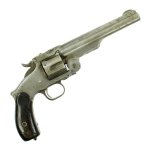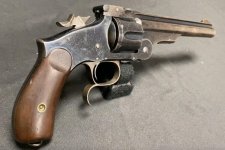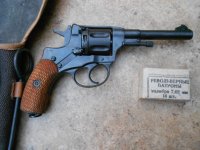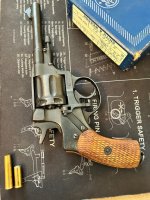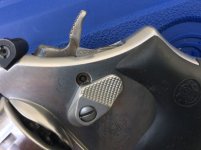Kasian
Well-known member
- Joined
- Dec 8, 2024
- Messages
- 57
- Reaction score
- 61
I am from NYC, S&W 66-8, 4.25". Having this most modern marvel one has to look back:
In the early 1870s, General Alexander Gorloff, the military attaché assigned to the Russian Embassy in Washington, D.C., approached Smith & Wesson about the possibility of negotiating a military sales contract for the purchase of a large number of Smith & Wesson Model 3 revolvers for the Imperial Russian Army.
However, Gorloff had some reservations about the standard .44 S&W American chambering of the pistol which, similar to today's .22 long rifle, had an externally lubricated heeled bullet. Gorloff correctly recognized that such ammunition tends to pick up debris and contaminants which erode the bore when fired, so a qualification of the purchase contract was that Smith & Wesson develop an internally lubricated version of their .44 round.
[ame]https://www.youtube.com/watch?v=z17aT3JzEDI[/ame]
44 Russian generated a much higher chamber pressure of 12,000 copper units of pressure (CUP) compared to the older .44 American round, which generated only 6,000–8,000 CUP. To prevent the new high-pressure ammunition from being fired in .44 American revolvers with disastrous results, the overall cartridge case length was increased by .06 in to 0.970 in.[1] In addition, the cylinder design of the No. 3 revolver had to be changed from the straight bored .
Over 131,000 S&W Model 3 revolvers were eventually sold to the Russian Army (pic 1) some copies were Tula-produced (Pic 2). In addition to the S&W-made revolvers, Belgian-, Spanish- and German-made copies were adopted by several European countries and were used until the 1920s. The .44 Russian chambering became a hit in the domestic market as well, gaining a reputation as the first American revolver cartridge offering inherent accuracy. In time it set many records, eventually becoming known as an established target round, enabling skilled shooters to achieve 3-inch (76 mm) groups at 50 yards (46 m); notable for the time and still impressive today.
Successor designs
The .44 Russian was the parent cartridge for the .44 Special introduced in 1907, which in turn was the parent to the .44 Magnum in 1956.
S&W .44Russian were replaced by Nagant revolvers
.
The Nagant was designed by Léon Nagant, whose brother Émile had also taken part in designing the Mosin–Nagant rifle. The Nagant M1895 was adopted as the standard issue sidearm for the Imperial Russian Army and police officers, where it replaced earlier Smith & Wesson models such as the Model 3.
Russia purchased the manufacturing rights in 1898, and moved production to the Tula Arsenal in Russia, and was soon producing 20,000 examples per year.
It was produced in two versions: a double-action version for officers, and a cheaper single-action version for the lower ranks. Seven Nagant revolvers were used by communist revolutionaries to kill the Russian imperial family and their servants in July 1918. After the Russian Revolution, only the double-action version was made.
Nagant revolvers were used by the NKVD and Red Army units until the end of World War II, with a total of 2,000,000 produced.[11] The Nagant began to be replaced by the Tokarev semi-automatic pistol in 1933, and was formally replaced by the Makarov in 1952, though Nagant revolvers continued to see limited use in the Korean War and Vietnam War. (WIKIPEDIA materials were used).
There was no own revolver production in USSR and in postcommunist Russia.
In the early 1870s, General Alexander Gorloff, the military attaché assigned to the Russian Embassy in Washington, D.C., approached Smith & Wesson about the possibility of negotiating a military sales contract for the purchase of a large number of Smith & Wesson Model 3 revolvers for the Imperial Russian Army.
However, Gorloff had some reservations about the standard .44 S&W American chambering of the pistol which, similar to today's .22 long rifle, had an externally lubricated heeled bullet. Gorloff correctly recognized that such ammunition tends to pick up debris and contaminants which erode the bore when fired, so a qualification of the purchase contract was that Smith & Wesson develop an internally lubricated version of their .44 round.
[ame]https://www.youtube.com/watch?v=z17aT3JzEDI[/ame]
44 Russian generated a much higher chamber pressure of 12,000 copper units of pressure (CUP) compared to the older .44 American round, which generated only 6,000–8,000 CUP. To prevent the new high-pressure ammunition from being fired in .44 American revolvers with disastrous results, the overall cartridge case length was increased by .06 in to 0.970 in.[1] In addition, the cylinder design of the No. 3 revolver had to be changed from the straight bored .
Over 131,000 S&W Model 3 revolvers were eventually sold to the Russian Army (pic 1) some copies were Tula-produced (Pic 2). In addition to the S&W-made revolvers, Belgian-, Spanish- and German-made copies were adopted by several European countries and were used until the 1920s. The .44 Russian chambering became a hit in the domestic market as well, gaining a reputation as the first American revolver cartridge offering inherent accuracy. In time it set many records, eventually becoming known as an established target round, enabling skilled shooters to achieve 3-inch (76 mm) groups at 50 yards (46 m); notable for the time and still impressive today.
Successor designs
The .44 Russian was the parent cartridge for the .44 Special introduced in 1907, which in turn was the parent to the .44 Magnum in 1956.
S&W .44Russian were replaced by Nagant revolvers
.
The Nagant was designed by Léon Nagant, whose brother Émile had also taken part in designing the Mosin–Nagant rifle. The Nagant M1895 was adopted as the standard issue sidearm for the Imperial Russian Army and police officers, where it replaced earlier Smith & Wesson models such as the Model 3.
Russia purchased the manufacturing rights in 1898, and moved production to the Tula Arsenal in Russia, and was soon producing 20,000 examples per year.
It was produced in two versions: a double-action version for officers, and a cheaper single-action version for the lower ranks. Seven Nagant revolvers were used by communist revolutionaries to kill the Russian imperial family and their servants in July 1918. After the Russian Revolution, only the double-action version was made.
Nagant revolvers were used by the NKVD and Red Army units until the end of World War II, with a total of 2,000,000 produced.[11] The Nagant began to be replaced by the Tokarev semi-automatic pistol in 1933, and was formally replaced by the Makarov in 1952, though Nagant revolvers continued to see limited use in the Korean War and Vietnam War. (WIKIPEDIA materials were used).
There was no own revolver production in USSR and in postcommunist Russia.
Attachments
Last edited:

